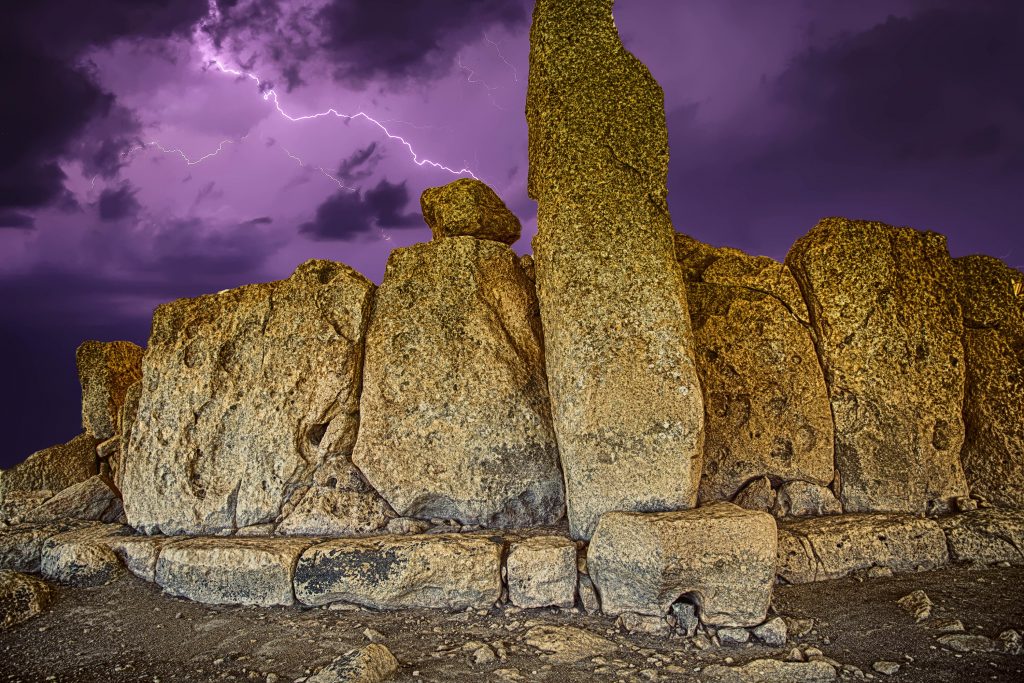
Göbekli Tepe is an archaeological site located about 10 miles from Urfa in southeastern Turkey. It’s intrigued scholars, historians, and the general public since its discovery in the 1960s. The name Göbeklitepe (both spellings are used) means “Potbelly Hill” in Turkish, and it refers to the distinctive shape of the hill on which the site is located. The site, which dates back to the Neolithic period, around 10,000 BCE, is the oldest megalithic site in the world.
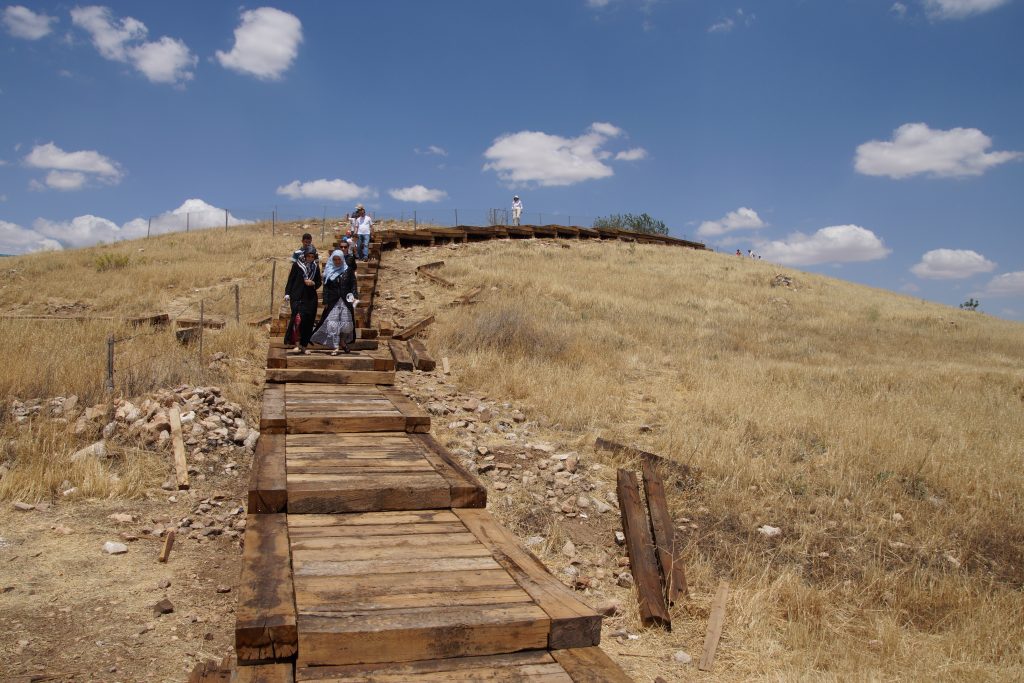
The site is thousands of years older than other examples of monumental architecture. Its megalithic temples were cut from rock millennia before the 4,500-year-old pyramids in Egypt, 5,000-year-old Stonehenge in England, or 7,000-year-old Nabta Playa ( the oldest known astronomical site).
Dating the various ‘ages’, often based on technology, is confusing as they occurred at different times for different geographical areas. The neolithic age is usually considered to start around 10,000 BCE to about 4500 BCE in the Near East (As it spread across Europe it extended, for example, until 2000 BCE in Scandinavia)
The early neolithic complex at Göbekli Tepe
consists of several large, circular stone structures, which were erected using massive, T-shaped stone pillars that weigh up to 16 tons each. The pillars have carved elaborate reliefs of animals, including lions, snakes, and birds, as well as stylized human figures.
The purpose of the site is still debated by archaeologists, while only a small section has been examined so far.
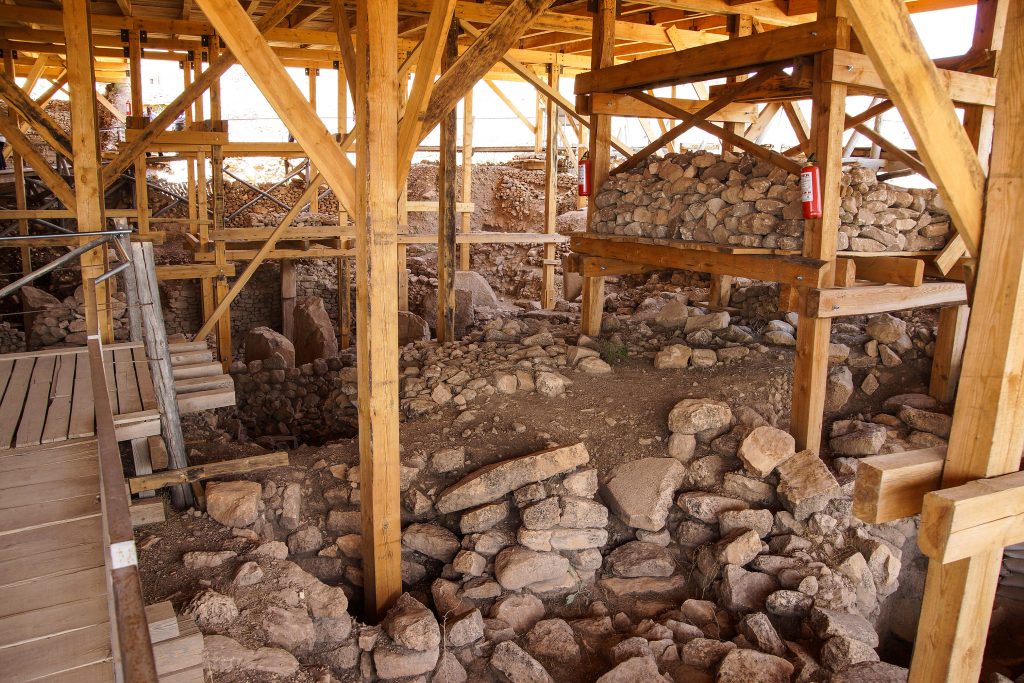
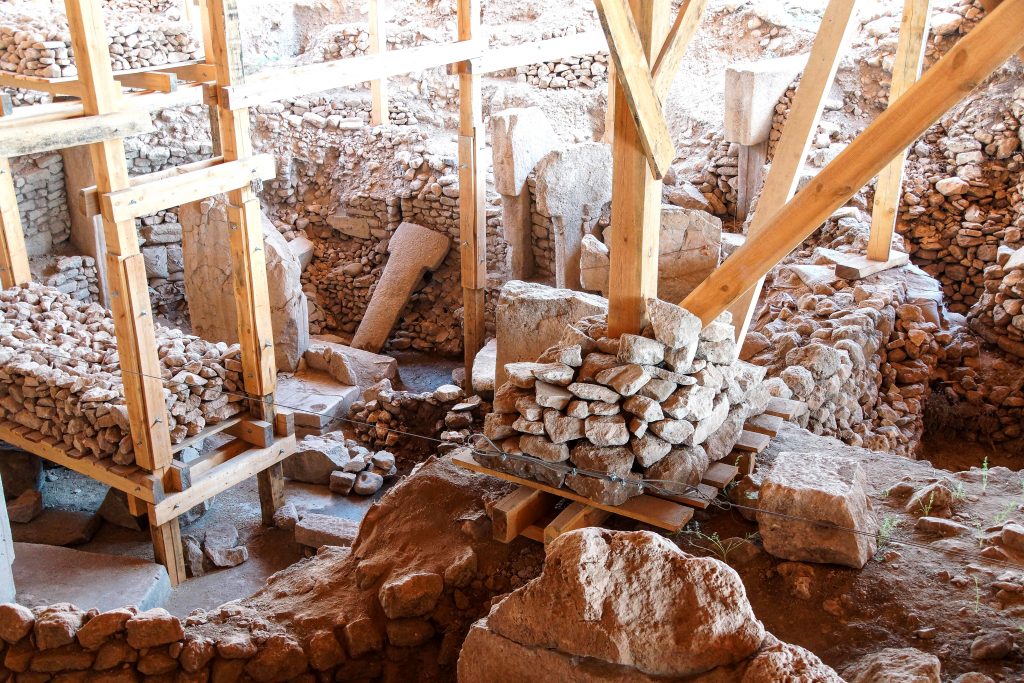
The site was discovered in 1963 during a survey carried out in partnership with the Universities of Istanbul and Chicago, but serious excavations only started in 1994
The discovery of Göbekli Tepe has challenged many long-held assumptions about the development of human civilization. It suggests that the impulse to create complex, organized religious structures may have preceded the development of agriculture and settled communities, rather than the other way around. Göbekli Tepe offers a fascinating glimpse into the earliest stages of human culture and provides a valuable perspective on the long arc of human history.
On our first visit in 2014, the site was just starting to be developed for tourist visits – workmen were installing gently inclined paths and there was a rudimentary covering to protect the diggings from rain – similar to those of Malta that cover other neolithic sites.
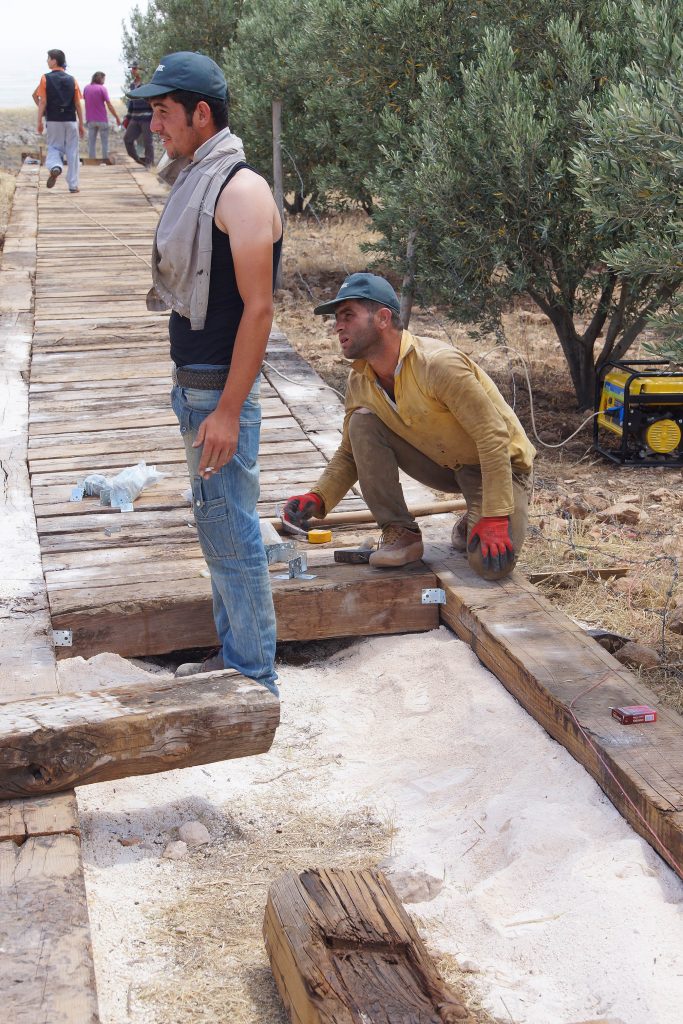
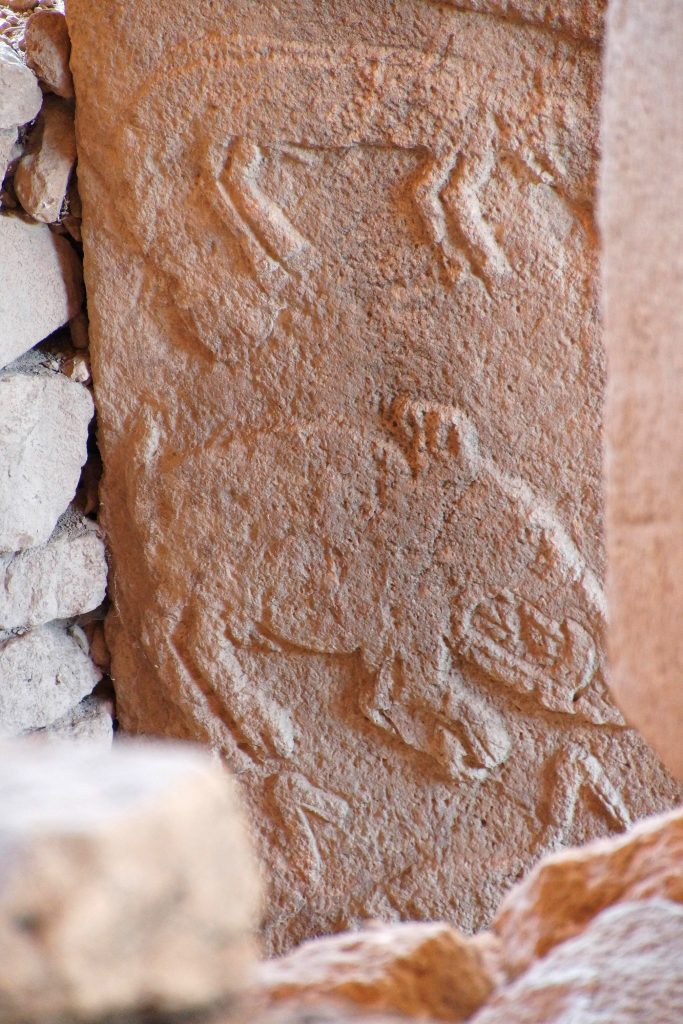
We followed a knot of workmen up the hill
to rectangular pits shaded by a corrugated steel roof—the main excavation site. In the pits, standing stones, or pillars, are arranged in circles. Beyond, on the hillside, are four other rings of partially excavated pillars. Each ring has a roughly similar layout: in the center are two large stone T-shaped pillars encircled by slightly smaller stones facing inward. The tallest pillars tower 16 feet and weigh 7-10 tons. Some are blank, while others are elaborately carved: foxes, lions, scorpions and vultures abound, twisting and crawling on the pillars’ broad sides.
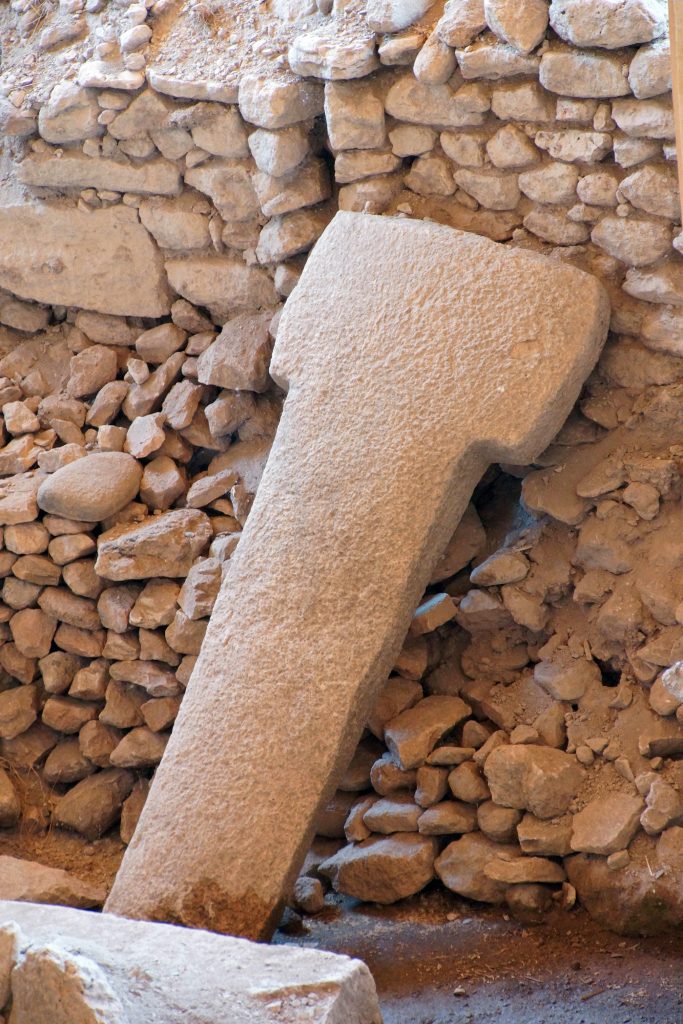
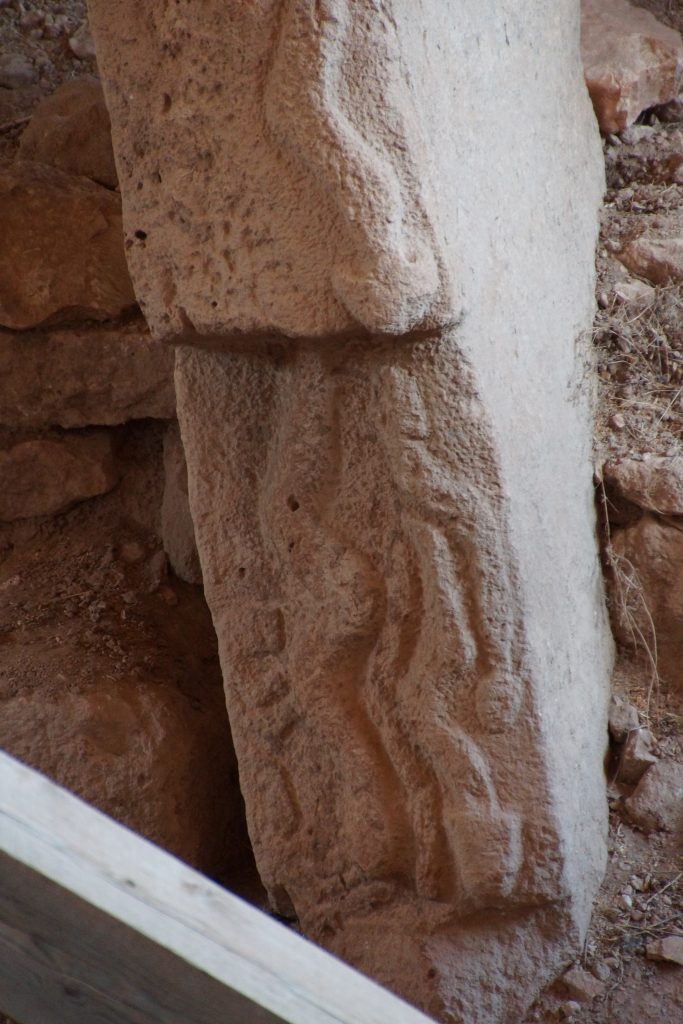
The settlement of Göbekli Tepe was built on a slope, with circular structures at the bottom and rectangular structures, now interpreted as dwellings, on the hill above. That interpretation supported the theory that Göbekli Tepe was built by hunter-gatherers, not settled farmers.
The entire summit has been surveyed using ground-penetrating radar and geomagnetic surveys, charting where at least 16 other megalith rings remain buried across 22 acres. The one-acre excavation covers less than 5 percent of the site. Archaeologists estimate they could dig here for another 50 years and barely scratch the surface.
Gobekli Tepe’s sloping, rocky ground is a stonecutter’s dream
. Even without metal chisels or hammers, prehistoric masons wielding flint tools could have chipped away at softer limestone outcrops, shaping them into pillars on the spot before carrying them a few hundred yards to the summit and lifting them upright. (Workers in ancient Egypt were able to extract huge granite obelisks using only stone tools) {?? aswan ??} Once the stone rings were finished, the ancient builders covered them over with dirt. Eventually, they placed another ring nearby or on top of the old one. Over centuries, these layers created the hilltop.
Traditional thinking said that only after people learned to farm and live in settled communities did they have the time, organization and resources to construct temples and support complicated social structures. But it may be the other way around: the extensive, coordinated effort to build the monoliths literally laid the groundwork for the development of complex societies.
— cite
archaeological evidence shows this to have been a surprisingly common pattern, which goes against conventional evolutionary assumptions about the effects of scale on human society. In each of the cases we’ve considered so far – Ukrainian mega-sites, Uruk Mesopotamia, the Indus valley – a dramatic increase in the scale of organized human settlement took place with no resulting concentration of wealth or power in the hands of ruling elites. In short, archaeological research has shifted the burden of proof on to those theorists who claim causal connections between the origins of cities and the rise of stratified states, and whose claims now look increasingly hollow.
The immensity of the undertaking at Gobekli Tepe reinforces that view. To carve, erect and bury rings of seven-ton stone pillars would have required hundreds of workers, all needing to be fed and housed. Hence the eventual emergence of settled communities in the area around 12,000 years ago.
“This shows sociocultural changes come first, agriculture comes later,” says Stanford University archaeologist Ian Hodder, who excavated Catalhoyuk, a prehistoric settlement 300 miles from Gobekli Tepe. “You can make a good case this area is the real origin of complex Neolithic societies.”
Download royalty free images of Gobekli Tepe
Neolithic Malta
The Maltese archipelago, located in the center of the Mediterranean, is home to a wealth of Neolithic archaeological sites. These sites provide valuable insight into the lives of the prehistoric people who lived on the islands around 5000 years ago.
These sites are accessible by bus, either the local bus or the more convenient Hop-On Hop-Off bus
I used it to visit several sites and the fishing village of Marsaxlokk during a cruise port day. I had to arrange to get back to Sliema early, though, since I wanted to hear the on-board lecture that day was by an archaeologist studying those sites.
The megalithic temples of Malta
date to the ‘ Temple Period ‘ (3600-2500 BCE). These temples are some of the oldest free-standing structures in the displaying the advanced engineering skills of the Neolithic people. The temples are characterized by their massive stone blocks, intricate carvings, and intricate decorations, which depict human and animal figures, spirals, and other abstract motifs.

Another significant Neolithic site in Malta is the Hypogeum of Hal-Saflieni, – an underground complex circa 4000 BCE. It has three levels, and it is thought to have been used for ritual purposes, including burials. The walls of the Hypogeum are adorned with elaborate paintings, carvings, and sculptures, which provide insight into the beliefs and practices of the Neolithic people.

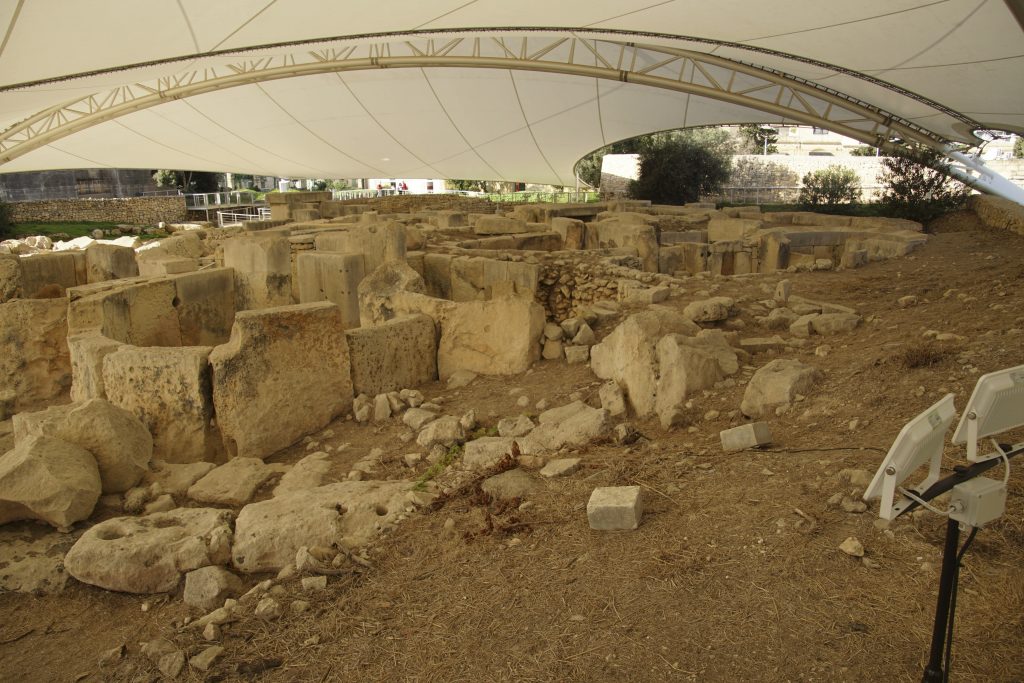
In addition to these monumental structures, there are also many other Neolithic sites scattered throughout the Maltese islands, including dolmens, tombs, and other megalithic structures. These sites provide further evidence of the complex and sophisticated society that existed on the islands during the Neolithic period.
Neolithic Sardinia
Relatively close to Malta ( Sicily is in the way), Sardinia also has many prehistoric sites.
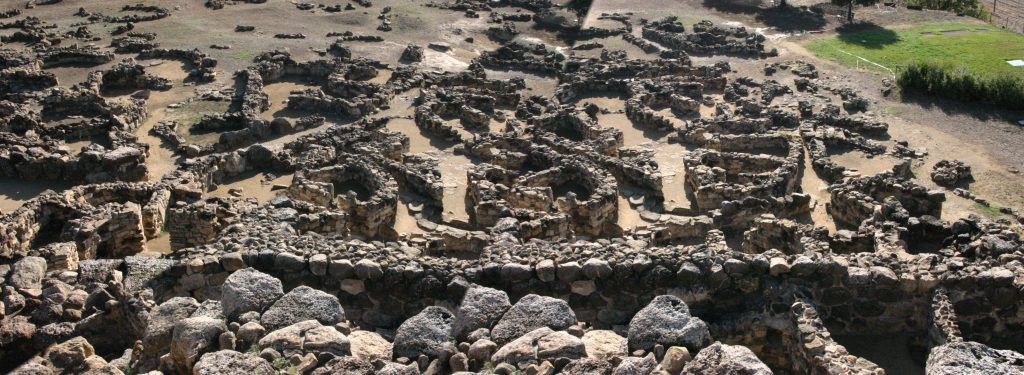
A common structure found on Sardinia is the Nuraghe, a complex of stone structures circa 1500 BCE. Nuraghe is a unique type of defensive structure that was built by the Nuragic civilization, which inhabited Sardinia during the Bronze Age. The complex consists of a central tower surrounded by smaller structures, all made of stone. The Nuraghe is a significant archaeological site because it provides insight into the advanced construction techniques and defensive strategies of the Nuragic civilization.
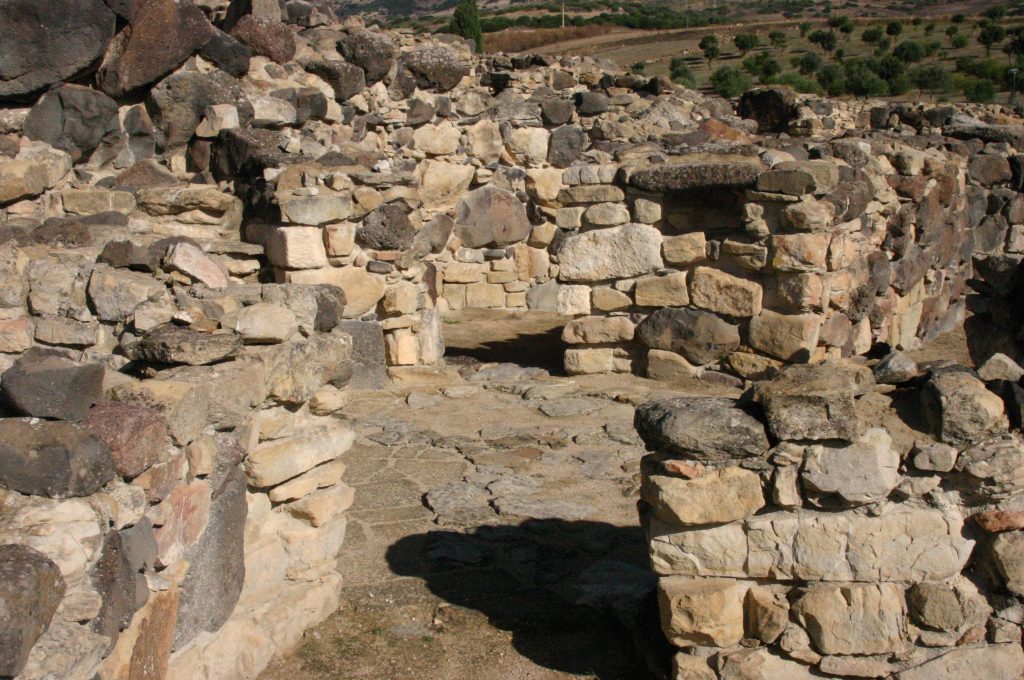

Another important Neolithic site on Sardinia is the Giants’ Grave, a collection of tombs dating back to 2500 BCE. These tombs consist of a large stone structure that is shaped like a trapezoid and has a small entrance on one end. Inside, the tombs are lined with smaller stones and contain the remains of multiple individuals. The Giants’ Grave is significant because it provides insight into the burial practices of the prehistoric inhabitants of Sardinia.
Tiers of patterned rock, prehistoric building,Nuraghe LosaSardinia, Italy
The Su Nuraxi di Barumini
is another notable Neolithic site on Sardinia. This site consists of a complex of stone structures that date back to the 16th century BCE. The site is significant because it provides insight into the social organization and political structure of the Nuragic civilization. The complex consists of a central tower surrounded by a series of smaller structures that were likely used for residential and agricultural purposes.
The Tomba dei Giganti, or the “Giants’ Tomb,” is another significant Neolithic site on Sardinia. This tomb dates back to 1600 BCE and consists of a large stone structure that is shaped like a longhouse. Inside, the tomb contains the remains of multiple individuals, as well as artifacts such as pottery and bronze objects. The Tomba dei Giganti is significant because it provides insight into the religious and funerary practices of the prehistoric inhabitants of Sardinia.